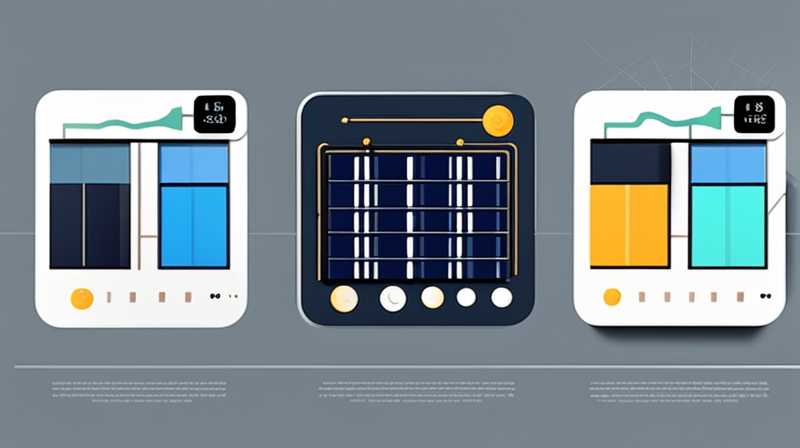
A solar cell typically produces between 0.5 to 0.6 volts, with variations depending on the type of cell and its design. 1. The most common photovoltaic cell, silicon-based, usually generates around 0.5 volts under standard test conditions. 2. Factors such as temperature, light intensity, and cell efficiency can influence voltage output significantly. A detailed examination of how these elements interact offers insight into optimizing solar energy conversion.
1. UNDERSTANDING SOLAR CELLS
Solar cells, or photovoltaic cells, are devices that convert light energy directly into electrical energy through the photovoltaic effect. This phenomenon occurs when photons, or light particles, strike a cell and transfer energy to electrons, enabling them to flow and create an electric current.
The material composition of a solar cell largely determines its voltage output. Most residential solar panels are composed of silicon, leveraging its semiconductor properties. Silicon cells, particularly monocrystalline and polycrystalline varieties, demonstrate unique characteristics that influence their efficiency and voltage generation.
The performance of a solar cell also hinges on its design and configuration. For example, the layering of silicon, the addition of conductive materials, and the cell angle relative to sunlight can significantly affect its output. Understanding these variables allows for improvements in solar technology and the design of more efficient solar systems.
2. VOLTAGE OUTPUT UNDER DIFFERENT CONDITIONS
The voltage output of solar cells is not static; it fluctuates based on various environmental and operational factors. Light intensity plays a crucial role in defining how much voltage a solar cell can generate. Under optimal bright conditions, a cell might produce closer to its maximum voltage, while cloudy or shaded conditions could result in a notable drop.
Temperature is another significant variable affecting performance. Solar cells typically operate less efficiently at higher temperatures. In extreme heat, the voltage output may decline, leading to less overall power generation from a solar panel system.
Moreover, the quality of manufacturing and materials utilized in solar cells can greatly impact their voltage output. High-quality silicon cells with fewer imperfections tend to provide more consistent and higher voltage outputs than low-grade alternatives. Consequently, the efficiency of solar systems can vary widely, leading to different energy production rates.
3. SYSTEM CONFIGURATION AND VOLTAGE
The arrangement of solar cells within a solar panel influences the overall voltage output. Cells can be connected in series or parallel, and these configurations yield different voltage characteristics.
In a series connection, the voltages add up, enhancing the output voltage from the entire array. This method is advantageous when aiming to reach higher voltages suitable for certain applications, such as residential systems connected to the grid. Conversely, parallel configurations maintain the same voltage but increase current capacity. These differences must be accounted for when designing solar power systems based on voltage requirements.
The overall efficiency of a solar system can also be influenced by how the individual cells are broken down into modules. By monitoring the performance of individual cells within a panel, systems can be optimized for performance, yielding maximized voltage outputs depending on operational requirements.
4. FUTURE DIRECTIONS IN SOLAR CELL TECHNOLOGY
As technology continues to evolve, substantial advancements are being made in solar cell efficiency and voltage output. Emerging technologies such as perovskite solar cells are at the forefront of innovation. These cells promise to enhance energy conversion rates and potentially offer higher voltage outputs compared to traditional silicon-based options.
Research into solar cell materials is not limited to efficiency gains; it also focuses on increasing the lifespan and reliability of solar cells under varying conditions. Long-lasting materials that can withstand extreme weather will contribute to more consistent power generation, further stabilizing voltage output.
The advent of bifacial solar panels, which capture sunlight on both sides, also serves as a critical leap forward. This innovative approach can lead to increased energy generation, thereby improving overall system voltage output under numerous environmental conditions. Such developments represent a promising future for solar technology and voltage enhancements.
FAQs
WHAT IS THE VOLTAGE OF A TYPICAL SOLAR CELL?
A standard solar cell typically generates approximately 0.5 to 0.6 volts under ideal conditions. This output can vary due to numerous factors, including temperature, light intensity, and solar cell type. Silicon-based cells are the most commonly used in residential applications due to their efficiency and cost-effectiveness.
HOW DO TEMPERATURE AND LIGHT CONDITIONS AFFECT SOLAR CELL VOLTAGE?
The efficiency of solar cells can be drastically influenced by temperature and light conditions. Under bright sunlight, a solar cell may achieve its peak voltage output. However, higher temperatures can reduce the voltage produced, which, combined with variable light conditions such as overcast skies or shading, can decrease the overall energy output considerably.
WHAT ARE THE BENEFITS OF SERIES AND PARALLEL CONNECTIONS IN SOLAR CELLS?
In solar energy systems, cells can be configured in series or parallel. Series connections add the voltage output of individual cells, beneficial for achieving higher voltage levels required for certain applications. Parallel connections, on the other hand, maintain the same voltage while increasing current capacity. Each configuration has its benefits, depending on the specific energy needs and system design of the solar installation.
The voltage output of solar cells represents a critical aspect of solar technology, affecting efficiency and energy production. Adjusting environmental and operational factors can notably influence performance, requiring a deep understanding for optimal deployment. Furthermore, advancements in solar technology point towards enhanced voltage outputs with new materials and configurations. Continuous research aims to refine solar cell efficiency, translating to greener alternatives in energy solutions. As we observe these developments, increased adoption and applications for solar technology are anticipated, solidifying its role as a cornerstone for sustainable energy systems in the years to come.
Original article by NenPower, If reposted, please credit the source: https://nenpower.com/blog/how-many-volts-is-a-solar-cell/


